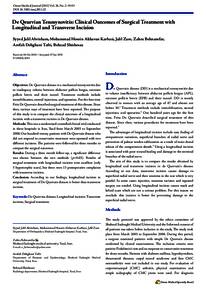Document
De Qeurvian tenosynovitis : clinical outcomes of surgical treatment with longitudinal and transverse incision.
Contributors
Karbasi, Mohammad H. A., Author
Zare, Jalil., Author
Behnamfar, Zahra., Author
Tafti, Arefah Dehghani., Author
Publisher
Oman Medical Specialty Board.
Gregorian
2011-03
Language
English
English abstract
Objectives: De Quervain disease is a mechanical tenosynovitis due to inadequacy volume between abductor pollicis longus, extensor pollicis brevis and their tunnel. Treatment methods include immobilization, steroid injections, and operation. For the first time Fritz De Quervain described surgical treatment of this disease. Since then, various ways of treatment have been reported. The purpose of this study is to compare the clinical outcomes of a longitudinal incision with a transverse incision in De Quervain disease. Methods: This was a randomized controlled clinical trial conducted in three hospitals in Iran, Yazd from March 2003 to September 2008. One hundred-twenty patients with De Quervain disease who did not respond to conservative treatment were operated with two different incisions. The patients were followed for three months to compare the surgical outcomes. Results: During a three month follow-up, a significant difference was shown between the two methods (p=0.03). Results of surgical treatment with longitudinal incision were excellent (only 5 hypertrophic scars), but there were 13 postoperative complaints with transverse incision. Conclusion: According to our findings, longitudinal incision in surgical treatment of De Quervain disease is better than transverse incision.
Member of
Resource URL
Citation
Abrisham, Syyed Jalil, Karbasi, Mohammad H. A., Zare, Jalil, Behnamfar, Zahra, Tafti, Arefah Dehghani, & Shishesaz, Behzad (2011). De Qeurvian tenosynovitis : clinical outcomes of surgical treatment with longitudinal and transverse incision. Oman Medical
Category
Journal articles

